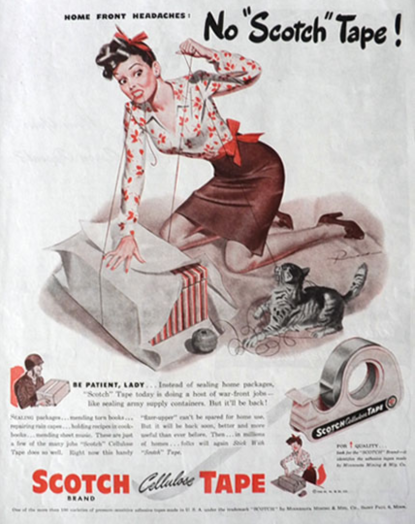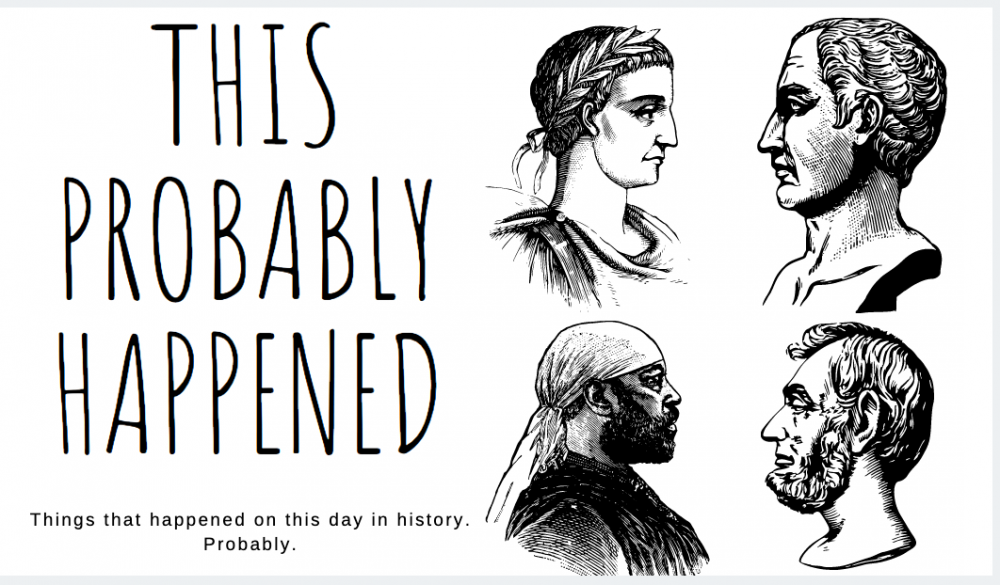
Vintage Scotch ad from the 1940s; Creative Commons
Chances are if I held up a piece of clear, pressure sensitive, self-sticking tape and asked you what it was called, you’d reply pretty matter of factly that it’s Scotch Tape, and chances are you’d be right. Scotch brand clear tape, manufactured by the 3M company, is one of more than 400 varieties of adhesive tapes and glues produced since its debut on this day, 88 years ago, and it’s hard to find another brand that rivals its popularity or prolificacy.
But Scotch is just that – a brand. The tape itself is just called adhesive tape, pressure-sensitive tape, office tape, or, more accurately, cellulose acetate polydimethyl-sioxane polyurethane tape.
Just rolls off your tongue, doesn’t it?
The lack of an agreed upon, accurate, easy to pronounce name for the actual item in question has contributed in part to why Scotch tape has become a part of our vernacular; the brand name is now synonymous with the product itself, much like Kleenex, Jello, and Coke. But the origins of the name are, surprisingly, steeped in controversy and based on an ethnic pejorative that was well-known at the time of its inception.

Image Credit: Richard Smith, Flickr; Creative Commons Use
The story actually begins with cars, and with the mother of all invention – necessity. In the mid 1920s, a young research assistant at 3M’s Minnesota headquarters named Richard Drew set out to develop an adhesive tape that would allow a precise and sharp two-tone paint job without mixing or bleeding of colors. Unfortunately, the prototype that he developed just wasn’t sticky enough, and he was told by one auto painter that he was being “Scotch” with the adhesive. Although to most modern readers this probably doesn’t seem like an insult, when used in that context it’s actually a disparaging remark that means cheap or stingy. People from Scotland are referred to as Scottish or Scots for that very reason.
Seems like an odd choice for a name, no? Not only is it essentially an ethnic slur, but it also doesn’t exactly instill confidence in the product’s performance. Regardless, Scotch Masking Tape was born as a result, and went on to be wildly successful.
By 1929, Drew had new challenges on the tape front. DuPont had developed cellophane, a transparent product that was soon being used in all sorts of food packaging, and producers were looking for a tape that could match its vitreous appearance. After quite a bit of trial and error, Drew and the team at 3M developed Scotch Brand Cellulose tape, and the rest is history. Its success allowed the company to prosper, remaining successful even through the Depression.
An interesting little tidbit about Scotch tape: through a process called triboluminescence, where friction produces light, quickly unwinding Scotch tape (by mechanical means) can produce not only a blue streak of light, but x-rays that in some cases can actually be used to image a human finger.
The world is a strange and beautiful place, my friends.
